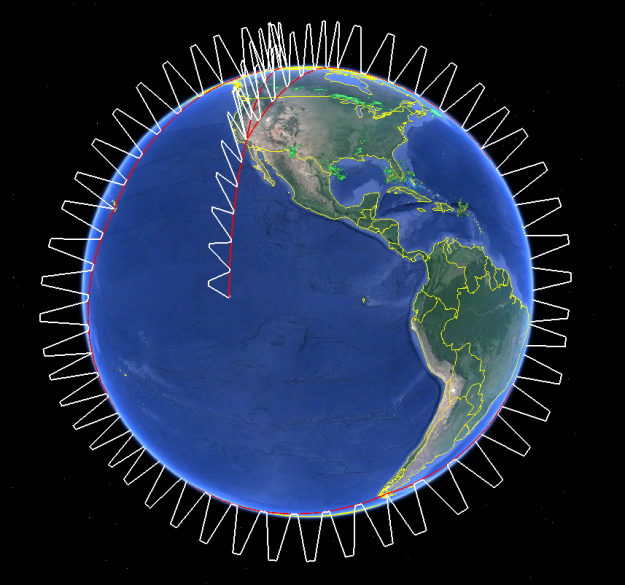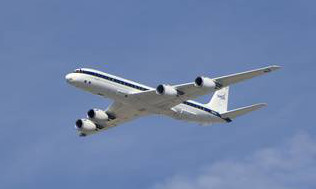Introduction
The Atmospheric Tomography Mission (ATom) will study the impact of human-produced air pollution on greenhouse gases and on chemically reactive gases in the atmosphere.
ATom’s tomographic, large-scale sampling combined with parcel-by-parcel quantification of photochemical tendencies provides a strong response to the 2011 NASA Strategic Plan to Advance Earth System Science: meeting the challenges of climate and environmental change on a global scale.
Motivation
ATom builds the scientific foundation for mitigation of short-lived climate forcers, in particular methane (CH4), tropospheric ozone (O3), and Black Carbon aerosols (BC). O3 is also a driver of tropospheric photochemistry and air quality. CH4 is a factor in rising levels of O3 and stratospheric humidity.
Science Questions
- Tier 1:
- What are chemical processes that control the short-lived climate forcing agents CH4, O3, and BC in the atmosphere? How is the chemical reactivity of the atmosphere on a global scale affected by anthropogenic emissions? How can we improve chemistry-climate modeling of these processes?
- Tier 2:
- Over large, remote regions, what are the distributions of BC and other aerosols important as short-lived climate forcers? What are the sources of new particles? How rapidly do aerosols grow to CCN-active sizes? How well are these processes represented in models?
- What type of variability and spatial gradients occur over remote ocean regions for greenhouse gases (GHGs) and ozone depleting substances (ODSs)? How do the variations among air parcels help identify anthropogenic influences on photochemical reactivity, validate satellite data for these gases, and refine knowledge of sources and sinks?
Description
ATom makes global-scale measurements of the chemistry of the atmosphere using the NASA DC-8 aircraft. Flights span the Pacific and Atlantic Oceans, nearly pole-to-pole, in continuous profiling mode, covering remote regions that might have been regarded as pristine 20 years ago but today receive long-range inputs of pollution from expanding industrial economies. The payload has 15 proven instruments for in situ measurements of reactive and long-lived gases, diagnostic chemical tracers, and aerosol size, number, and composition, plus spectrally resolved solar radiation and meteorological parameters.
ATom measures more than 100 distinct chemical, aerosol, radiative, and physical parameters. Fast instrument sampling rates provide spatially resolved, simultaneous, and contiguous observational data, providing a nearly complete chemical description of each air parcel.
Combining distributions of aerosols and reactive gases with long-lived GHGs and ODSs enables disentangling of the processes that regulate atmospheric chemistry: emissions, transport, cloud processes, and chemical transformations. ATom analyzes measurements using customized modeling tools to derive daily averaged chemical rates for key atmospheric processes and to critically evaluate Chemistry-Climate Models (CCMs). ATom also differentiates between hypotheses for the formation and growth of aerosols over the remote oceans.
ATom is closely linked to satellites measuring atmospheric chemical composition: (i) ATom provides unique data for validation and algorithm development for OCO-2, GOME-2, TROPOMI, GOSAT, plus those planned for geostationary orbit (TEMPO), and the TCCON network. (ii) ATom uses satellite data to extend its airborne in-situ observations to global scale. (iii) ATom directly engages CCM groups and delivers a single, large-scale, contiguous in-situ data set for model evaluation and improvement.
Significance
ATom delivers unique data and analysis to address the Science Mission Directorate objectives of acquiring “data sets that identify and characterize important phenomena in the changing Earth system.” and “measurements that address weaknesses in current Earth system models leading to improvement in modeling capabilities.” ATom will provide unprecedented challenges to the CCMs used as policy tools for climate change assessments, with comprehensive data on atmospheric chemical reactivity at global scales, and will work closely with modeling teams to translate ATom data to better, more reliable CCMs. ATom provides extraordinary validation data for remote sensing.
ATom Deployment Schedule
| Campaign | Upload | Deployment | Download |
|---|---|---|---|
| ATom-1 (Summer 2016) | Jun 20 - Jul 27 | Jul 28 - Aug 22 | Aug 23 - Aug 26 |
| ATom-2 (Winter 2017) | Dec 4 - Jan 27 | Jan 26 - Feb 22 | Feb 23 - Feb 25 |
| ATom-3 (Fall 2017) | Aug 14 - Sep 27 | Sep 28 - Oct 26 | Oct 27 - Oct 30 |
| ATom-4 (Spring 2018) | Mar 12 - Apr 23 | Apr 24 - May 21 | May 22 - May 25 |
Platform
The NASA DC-8 flight operations are provided by NASA /Armstrong Flight Research Center based out of Bldg 703 in Palmdale, CA. The University of North Dakota National Suborbital Education and Research Center provides science mission operations including payload integration engineering, data display and satcom systems and support, and education and outreach for the program.
The DC-8 is a four-engine jet aircraft with a range in excess of 5,000 nmi (9,200 km), a ceiling of 41,000 ft (12,500 m), and an experiment payload of 30,000 lb (13,600 kg). Utilization is planned to be 350 to 500 flight hours per year.
Instruments
| Instrument | Measurements |
|---|---|
| AMP (In Situ Measurements of Aerosol Microphysical Properties) | Dry aerosol particle size distribution, Cloud droplet size distribution, Dust size distribution, Precipitation Size, Cloud Liquid Water Content |
| AO2 (NCAR Airborne Oxygen Instrument) | O2, CO2 |
| ATHOS (Airborne Tropospheric Hydrogen Oxides Sensor) | OH, Napthalene, HO2, NO |
| CAFS (CCD Actinic Flux Spectroradiometers) | Actinic Flux |
| CAPS Vienna (Cloud Aerosol and Precipitation Spectrometer - U Vienna) | Aerosol, Particle size distribution, Cloud Liquid Water Content |
| CIT-CIMS (Chemical Ionization Mass Spectrometer) | HNO3, H2O2, CH3OOH, HCN, PAA, PNA, SO2 |
| DLH (Diode Laser Hygrometer) | H2O |
| GT-CIMS (Chemical Ionization Mass Spectrometer) | HNO3, SO2, HNO4, HCl, Br2, BrO, PAN |
| HR-AMS (CU Aircraft High-Resolution Time-of-Flight Aerosol Mass Spectrometer) | Cl, NH4, NO3, Organic Aerosol, SO4 |
| ISAF (In Situ Airborne Formaldehyde) | CH2O |
| Medusa (Medusa Whole Air Sampler) | O2, CO2, N2, Argon, CO2 isotopes |
| MMS (Meteorological Measurement System) | Wind, Turbulence, Temperature, Aircraft position |
| NOAA CIMS (Chemical Ionization Mass Spectrometer) | H2O, HNO3, HCl |
| NOAA Picarro (NOAA Picarro) | CO2, CH4, CO |
| NOyO3 (NOAA Nitrogen Oxides and Ozone) | NO, NO2, NOy, O3 |
| PALMS (Particle Analysis By Laser Mass Spectrometry) | Particle Composition, Aerosol |
| PANTHER (PAN and Trace Hydrohalocarbon ExpeRiment) | (CH3)2CO, PAN, H2, CH4, CO, N2O, SF6, CFCl3, CF2Cl2, Halon-1211 |
| PFP (Programmable Flask Package Whole Air Sampler) | N2O, SF6, H2, CS2, OCS, CO2, CH4, CO, CFCs, HCFCs, HFCs, Solvents, Methyl Halides, Hydrocarbons, Perfluorocarbons |
| QCLS (Quantum Cascade Laser System) | CO2, CO, CH4, N2O |
| SAGA (Soluble Acidic Gases and Aerosols) | Na, NH4, K, Mg, Ca+2, Cl, Br-, NO3, SO4, C2O4-2, Be-7, Pb-210, HNO3, Fine Aerosol SO4, Fine Aerosol NO3 |
| SP2 (Single Particle Soot Photometer (NOAA)) | Black Carbon, Scattering Aerosols |
| TOGA (Trace Organic Gas Analyzer) | VOCs |
| UCATS (UAS Chromatograph for Atmospheric Trace Species) | N2O, SF6, CH4, CO, O3 |
| WAS UCI (Whole Air Sampler) | NMHCs, Halocarbons, Alkyl Nitrates, OCS, DMS, CS2 |
Models
- CAM-Chem (Community Atmosphere Model with Chemistry): Chemical climatology, including reactivities for typical years and time of ATom-1 flights.
- GEOS-Chem (Goddard Earth Observing System (GEOS) with Chemistry): Chemical climatology, including reactivities for typical years and time of ATom-1 flights
- GEOS-5 (Goddard Earth Observing System Model, Version 5): GEOS5 fp meteorological products interpolated to the flight track: winds, vorticity, humidity, temperature, simply specified tracers (CO, SO2, many aerosol types)
- GFDLAM3 (the atmospheric component of the GFDL coupled model CM3): Chemical climatology, including reactivities for typical years and time of ATom-1 flights
- GISSE2 (GISS series of coupled atmosphere-ocean model): Chemical climatology, including reactivities for typical years and time of ATom-1 flights
- GMI (Global Modeling Initiative): GMI full chemistry CTM hindcast: gas-phase chemistry (40 species) along 10-sec merge, interpolated to the flight track
- GMI4D (Global Modeling Initiative 4D): GMI CTM hindcast with 4D grid bounding flight path: gas-phase chemistry (40 species) at: ¼ hr, 1° latitude, 1.25° longitude, standard model levels
- GMICTM (GMI chemistry and transport model): Chemical climatology, including reactivities for typical years and time of ATom-1 flights
- UCICTM (UCI chemical transport model): Chemical climatology, including reactivities for typical years and time of ATom-1 flights
- WRF (Weather Research and Forecasting): 3D back trajectories for ATom parcels along flight path; Convective influence for ATom parcels along flight path; Boundary Layer influence for ATom parcels along flight path; Convective and Boundary Layer influences for ATom parcels along flight path

